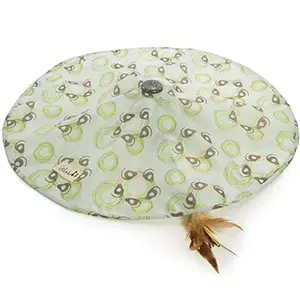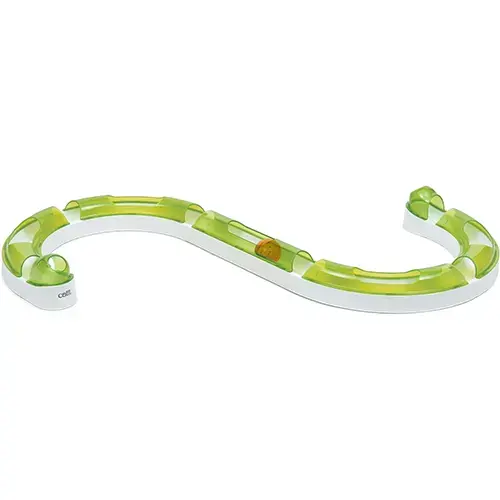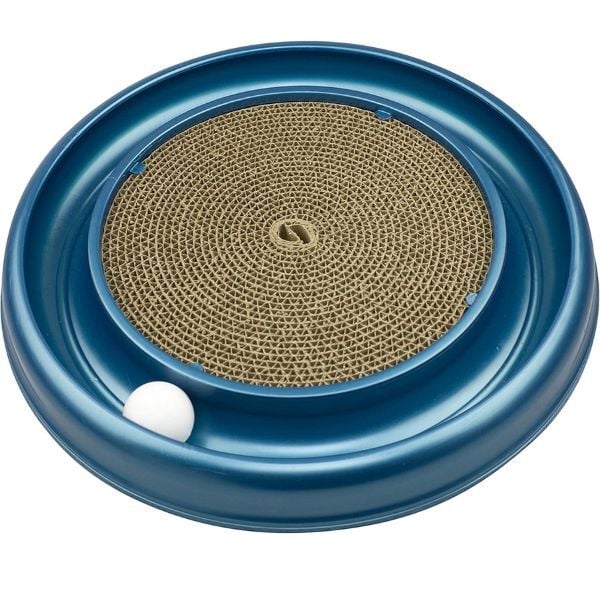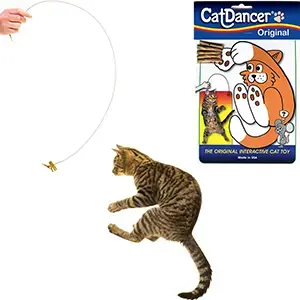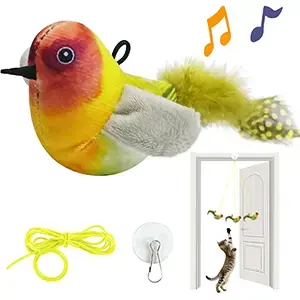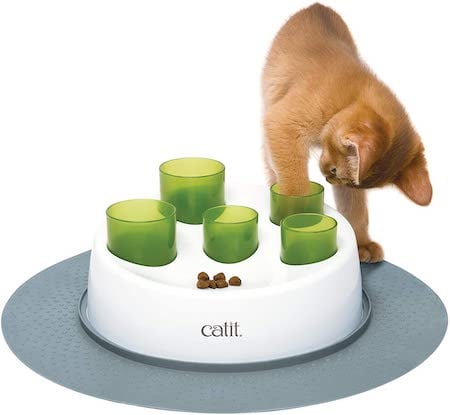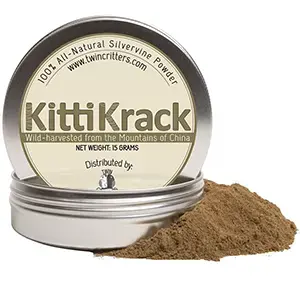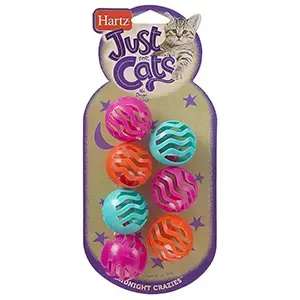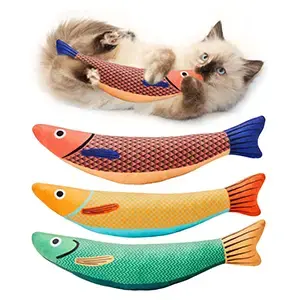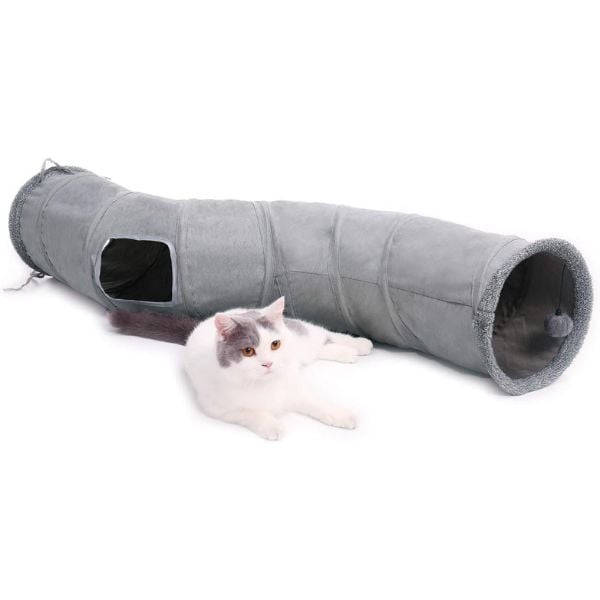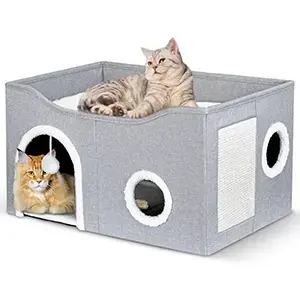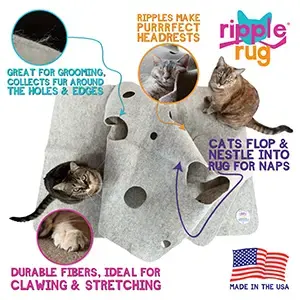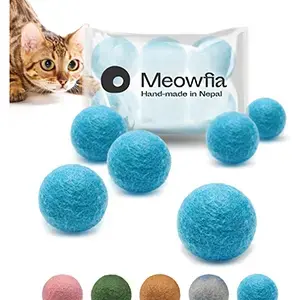 Sure, age is a state of mind. It’s also a state of body, when it comes to your cat.
Sure, age is a state of mind. It’s also a state of body, when it comes to your cat.
That’s because cats start their lives incredibly active and mobile. But they probably won’t be able to keep up that activity level in their later years.
Does that mean they should lounge and sleep all day when it gets tough to run and jump?
Absolutely not! Quite the opposite.
That’s the time to get creative — finding new and exciting ways to keep your senior cat physically and mentally active based on what their bodies can handle.
Skip to Section:
Activity Considerations for Senior Cats
The Prevalence of Osteoarthritis
Play & Enrichment Ideas for Cats with Mobility and Endurance Issues
Play & Enrichment Ideas for Cats with Limited Vision
Play & Enrichment Ideas for Cats with Limited Hearing
Play & Enrichment Ideas for Cats with Limited Sense of Smell
Play & Enrichment Ideas for Cats with Cognitive Decline
Signs of Pain or Discomfort in Cats
Considerations for Senior Cat Play and Enrichment
 Each cat is unique and will age in their own way, though keeping them active in their earlier years can certainly improve their chances of improved mobility later in life.
Each cat is unique and will age in their own way, though keeping them active in their earlier years can certainly improve their chances of improved mobility later in life.
Whether your cat is just a little slower than they used to be, extremely limited, or even dealing with cognitive decline, you can work within their limits. The first step is understanding those limits.
Here are some things to consider:
- Talk to your veterinarian. Your vet is a key resource when it comes to understanding your cat’s physical and mental limitations.
They can help you understand what’s painful, what type of movements could make things better or worse, and what may not move the way it used to.
Your vet can also help determine what diets, supplements, and medications will ease pain, help with cognitive issues and anxiety, which will also help make them want to play! - Trust your instincts. You watch your cat every day and may be more aware of their creaks and wobbles than you realize.
Even if your vet doesn’t call out a specific ache or pain, you may notice one — like your cat favoring one leg just a little or being able to jump on the bottom tier of their cat tree but not up to the couch. Keep those things in mind. - Walking and running. Is your cat moving more slowly, or do they still get zoomies and fly down the hallway?
- Pouncing and jumping. Maybe your cat does well moving horizontally. But when it comes to pouncing on that toy or jumping on the bed, it’s a different story. (This was my cat when her knees went bad.)
- Stability. Things like arthritis and weakening muscles can make it harder for your cat to balance on skinny edges like the windowsill or back of the couch or feel stable on soft surfaces like the couch cushions. It can also be harder to move across slick surfaces like a tile or wood floor.
- Endurance. Even if your cat is still pretty mobile, they may not be able to keep it going for long.
You’ll want to watch closely for signs they’ve had enough, like slowing down, breathing heavily, or even just flopping over and taking a break. Don’t push.
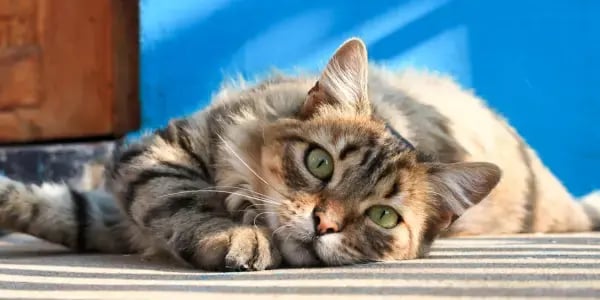
- Aches and pains. Even if your cat doesn’t have a diagnosed mobility issue, like arthritis, they may still be feeling their age. Joints can lose lubrication. Muscles can weaken. Injury can happen more easily.
- Eyesight. Has your cat’s vision changed? They may not see small toys, toys at a distance, or certain colors as well as they used to.
- Hearing. Hearing loss can play an important role in physical and mental enrichment. If your cat isn’t hearing as well these days, you’ll need to adjust a few things.
- Smell. If your cat’s sense of smell has diminished, using treats and catnip in play and enrichment may need to be done a bit differently.
- Past injuries. If your cat had an injury in their younger days, like a broken bone or orthoscopic surgery, they may get little flare-ups and aches as they get older.
- Paw and nail health. It’s not just the big bones and muscles. Your cat’s paws are hugely important in their mobility.
Any cat, but especially older cats, could have thicker nails that can grow into the paw pad, sensitive or dry paw pads, or other issues.
Their nails don’t shed like when they were younger. This can affect a cat's gait since they can’t fully retract the claws. Nails can also be more brittle which leads to more nail injuries and infections. And many declawed cats often experience paw pain throughout their lives.
Even if you’re just trimming your senior cat’s nails less often, the long nails could impact their ability to walk and run. - General health issues. There are medical issues often seen in senior cats that can impact their mobility and cognitive health. Things like arthritis, which we discuss below, can cause joint pain and limit movement.
Things like heart conditions and high blood pressure may mean activity needs to be low impact with lots of breaks. Even medications for medical conditions may play a role. Your vet can help with this.

A Word About Osteoarthritis
One of the most common issues senior cats face is arthritis, leading to joint pain and loss of mobility.
It’s thought that as much as 90% of cats over 10 years old have some degree of osteoarthritis (OA).1
It can range from mild to very painful. We also know that cats are chronically under-treated for pain. That’s because they’re incredibly good at hiding pain and discomfort.
When you’re a prey animal in the wild, you don’t want to advertise your health issues. So, cats power through pain without much acknowledgment. When it comes to OA, it’s usually us noticing they’re not jumping on the furniture like they used to, which leads to a vet visit and diagnosis.
But odds are your cat is feeling the impacts well before you notice those changes. That’s why it’s so important that your vet makes sure to do orthopedic exams in your senior cat’s wellness exams every 6 months or so.
For the most accurate diagnosis, you can request radiographs of major joints including the spine.
There is also thermography — which is a non-invasive way to diagnose pain and inflammation.
Be proactive. Don’t wait for your cat to show you they’re in pain. There are easy things you can do like helping your cat maintain their ideal weight to keep pressure off of their joints. You may also consider giving them joint supplements.
Play and Enrichment for Your Senior Cat
Let’s take a look at different types of play and enrichment and the ways you can modify them depending on your cat’s limitations.
Mobility and Endurance Issues
If your cat can’t move well, whether it’s limited walking/running, jumping/pouncing, or balance/stability, give these ideas a try. Use those most relevant to your cat’s situation and make your own adjustments as needed.
Play
Wand toy play. Using a wand toy allows you to easily move the toy in a way that works for your cat’s abilities. You can make small movements close to them so they don’t have to run after it (But not too close. Cats can’t see well within about 1 foot of their face).
It can dangle and bounce right above them while they’re lying on their back or hop like a bird on the ground where they’re sitting. You can move it around small obstacles like the legs of the coffee table or in and out of a cat cave.
Replicate sneaky prey. Move a wand toy under a sheet or blanket, like a mouse sneaking under the covers. That’s an easy one for your cat to smash with one paw or flop down on top of without doing a big jump and pounce.
Cut large holes in a box and move the toy inside the box so your cat can grab it through the holes. Change the sound that the toy makes by moving it on different surfaces. This can really spark your cat’s interest.
Try stationary self-play toys. There are battery-powered options with stationary bases and small elements that move. Some have tiny, furry things that pop in and out of different openings.
Non-electric options may include some sort of ball and track or a small critter at the end of a floppy wire, perfect for batting. If your cat can sit comfortably and use their front paws, these are great options.
Play on a rug or blanket. Slick surfaces like wood and tile can be hard to stabilize on if your cat has mobility issues.
Use stuffed kicker toys. These let your cat grab and bunny kick while they’re lying down. You can even get them with catnip stuffing.
Try hanging toys. There are string toys that hang from above so your cat can bat at them. Hang them low enough that your kitty doesn’t have to jump to reach them.
Use stable surfaces. Keep play sessions on large, flat surfaces like the ground or bed.
Don’t go too high. For cats who can’t jump, keep toys close to the ground so your cat doesn’t have to jump to catch them.
When Preventive Vet team member Mia's baby niece came to visit, her cat Mazel fell in love with one of her toys. This fidget spinner suctions to the wall or can be played with on the floor and makes an excellent enrichment activity for senior cats, cats with mobility issues, and cats like Mazel who are a little bit lazy when they play.
Enrichment
Food puzzles are fantastic brain work and require very little mobility. The larger the opening, the easier the puzzle is to work.
Even something as simple as hiding some treats around the room so your cat can sniff them out and take their time hunting them down is a wonderful way to get them moving a little and using their brains.
For a simpler option that doesn’t require walking, get a Snuffle Mat and hide treats in it for your cat to find.
How about some training? Clicker training is so much fun! It gets your cat using their brain. And you can focus on teaching behaviors that work for your cat’s mobility level.
Ringing a bell, booping your finger with their nose, slowly following a target, sitting or lying down … the options are endless.
Cat School on YouTube is an incredible resource for really simple clicker training instruction.
Try a foraging box or bag. Grab a few things from outside — a stick, a couple of rocks, a tree leaf. Put them in a bag or box, and just let your cat investigate. Make sure you’re not bringing in anything dangerous, and stay close to supervise.
You don’t want your cat eating anything. It’s an opportunity for them to use the senses they’d use outside. They may only be interested for a few minutes. That’s OK.
Instead of seeing and smelling the same thing all day, every day, you sparked their curiosity with something new. And now you can toss it all back outside.
Set up bird and other critter feeders near windows. Make sure your cat has a wide, stable perch near the window and an easy way to get up to that perch, like a ramp or steps. You can get bird feeders that suction to the window.
Just make sure they’re secured well so your cat can’t knock it out of the window and escape if they lunge at it.
Give your cat TV time. Some senior cats will watch cat videos just like they’re looking out a window. You can find hours of videos on YouTube with birds, mice, whatever your cat enjoys. We've even created some cat TV videos showing the wildlife in one of our team member's yards in Seattle.
Catnip and silvervine can give your senior cat a few minutes of fun. They may roll in it or eat it. You can sprinkle it on toys to encourage play. If your cat doesn’t respond to catnip, give silvervine a try.
The catnip response is genetic. They either have it or they don’t. Silvervine is more intense.
I strongly suggest you avoid silvervine sticks. Get the ground powder instead.
A cat who really likes silvervine is going to chew on the stick form. That can lead to splinters, punctures, blockages, and other scary medical emergencies.
Set up a scent-work activity. Grab your smelliest wet food or Churu. With your cat in another room, set up a few small dishes with a tiny amount of the food or treat. Then, let your cat in to find the dishes.
Start really simple with the dishes near each other. As they catch on, you can make it more difficult. But keep them on the floor if your cat can’t jump comfortably. They can move at their own pace, sniffing out the hiding spots.
Even setting up a few small boxes with holes cut in them and placing them right in front of your cat is a fun activity where they can figure out which box hides the food without having to move much.
Limited Vision
Cats can still be active without their sight. Lean into their other senses.
Focus on Smell
Use treats that have some stink to them. Get a variety of treats and lay a few of each in front of your cat. You’ll know right away which ones they smell easily. You can even use a little water from canned tuna (not oil) on the treats.
You can put those treats in really simple food puzzles, like a muffin tin. Drop a treat in the cup and put a small toy on top of it for added difficulty. Or cut large holes around the edges of a box and put the treats inside for your cat to fish out.

Even just placing your treats in the open near your cat lets them use their noses to sniff them out.
Use catnip on toys. They can smell the nip, which makes the toys easier to find. You can rub dried catnip on toys, spritz them with catnip spray, or marinate them in a bag of dry nip.
Focus on Sound
Use wand toy lures with bells. They’ll make a sound as they move. Even just hard metal or plastic pieces will make a sound when they bounce or rub on hard surfaces.
Use self-play toys with noise-makers. You can find balls with bells inside so they jingle as they roll or stuffed toys that make crunchy sounds. This kind of toy is great for interactive play.
Your cat can hear you moving the toy around and follow or locate it as it moves. It can also help with self-play.
Focus on Touch
Kitty tunnels and caves can be a lot of fun for cats who can’t see. They can let loose and roll around within the confines of the tunnel or cave. It keeps toys close as they’re playing. It’s like a ball pit for cats.
Try a Ripple Rug. This rug is a great touch experience. It’s full of holes, and you can change it up so your cat is getting new experiences as they reach in the holes, try to find the toys or treats you’ve hidden, and even crawl in the larger spaces.
Where you play matters for vision-impaired seniors. It helps to play in the same couple of areas so your cat knows the space and doesn’t have to worry about running into anything. That means keeping the layout of that area consistent and making sure they have room to move freely.
Keep play on the ground so you don’t have to worry about them falling off the surface.
Limited Hearing
If your cat can’t hear well, focus on sight and smell.
Look for toys in blues and greens. Cats see those colors most clearly. But if you’re playing on a blue or green rug, they’ll be harder to see. Larger toys can also help.
Use visual training. Just because your cat can’t hear a clicker for clicker training doesn’t mean you can’t train them as a form of enrichment. Just replace the click with a short, clear visual marker like a quick open and close of your raised hand.
You could even try a vibration like tapping something on the floor so your cat feels it in their feet.
Use anything stinky. Treats for food puzzles or treat hunts, catnip, silvervine, etc., will all grab your cat by the nose.
Limited Sense of Smell
In this case, the only significant change to play and enrichment would be around using treats. Your cat won’t be able to smell a treat, which means there is no hiding them. But you can certainly still find treats they like and put them in food puzzles.
You may need to show them the food puzzle is ready and even leave a treat or two next to it to draw them in.
Cognitive Decline
In this situation, each cat is unique. As we did above, think about what your cat can do, what senses they have intact, what mental abilities they can access.
Anything is better than nothing.
Finding something simple they can do for a couple of minutes a few times a day could make a huge impact in their quality of life — even if it’s just you and your cat sitting in the window watching birds together.
Signs Your Senior Cat May Have Pain or Discomfort
Above all, with any of these activities, you want to watch your cat for clues that they’ve had enough.
You don’t want to push too far. This isn’t about getting their heart rate up. It’s about sparking their prey drive, letting them feel like they’re hunting, and keeping their minds active.
You may want to consider ending each play session with some cryotherapy. Wrap a bag of ice or an ice pack in a towel or cloth and gently apply it to any areas of discomfort on your cat for no longer than 15–20 minutes as long as they will allow you and they aren't in distress.
Safety Note: Never apply ice or an ice pack directly to your cat's fur or skin. There must always be a towel or cloth between the cold compress and your cat's body.
Remember, cats are great at hiding pain. If you can physically see they’re in pain, it’s significant pain, and you should contact your veterinarian right away.
Limping or favoring a leg, whining, suddenly hiding, suddenly avoiding touch, getting aggressive when touched, unwillingness to get up, or other sudden changes in their normal behavior could be signs of injury or pain.
If they slow down, lose interest, flop over on the toy, or leave the room, that’s a good indication they may need a break, though sometimes they will fake you out, leaving so they can stalk their prey from farther away.
If your senior cat (or really any age cat) is panting, stop. Cats don’t pant the way other animals do. They’re not designed for extended periods of high-energy activity.
Even when they hunt, it’s not a marathon. It’s a sprint. A panting cat during play means they’ve overexerted and need to stop.
If your cat's panting continues for more than a few minutes, you should seek veterinary care.
Remember, play is less about wearing them out and more about meeting that instinctual need to stalk, chase, pounce, and grab — hunting and catching their prey.
With these tips, you can help your senior cat age with mobility, mental strength, and grace.



